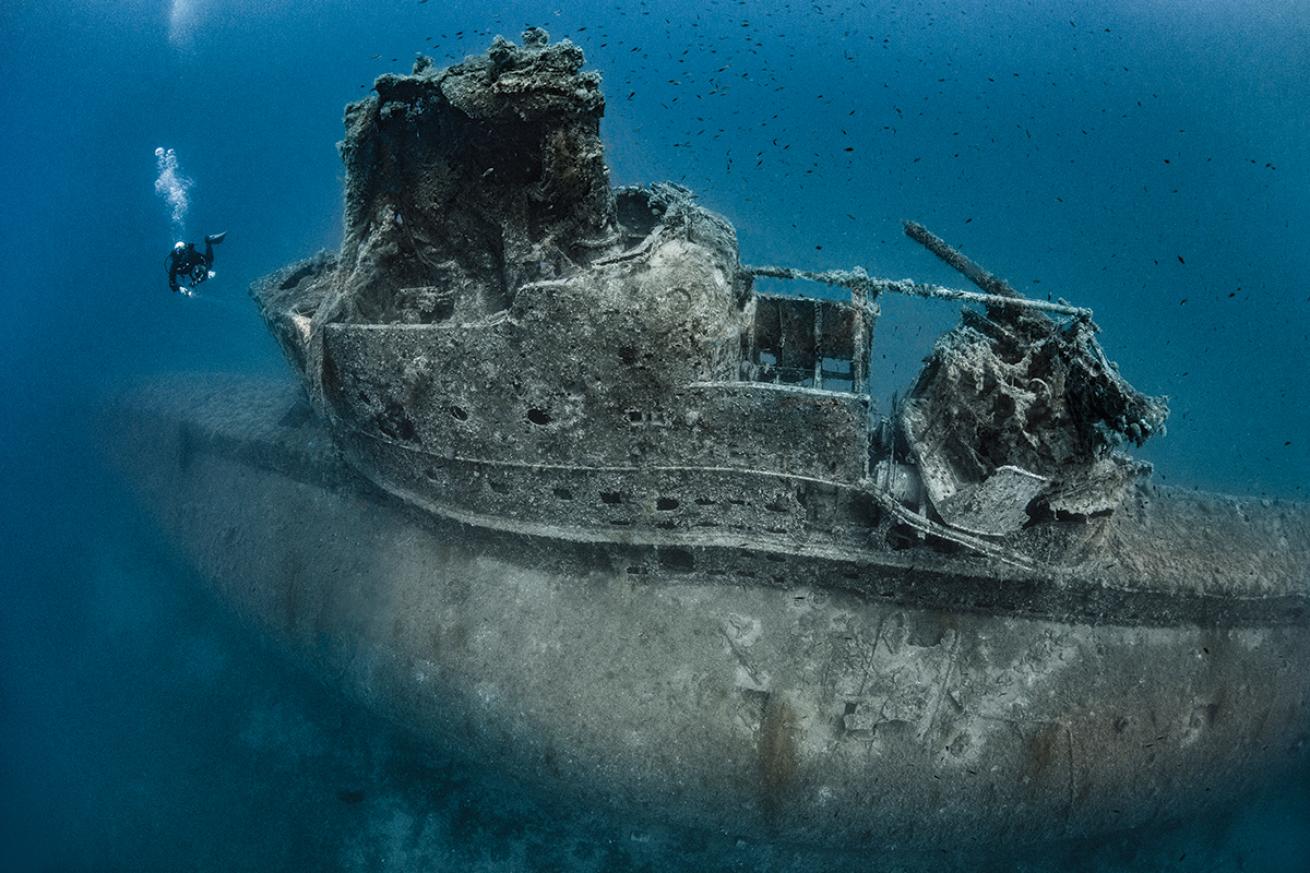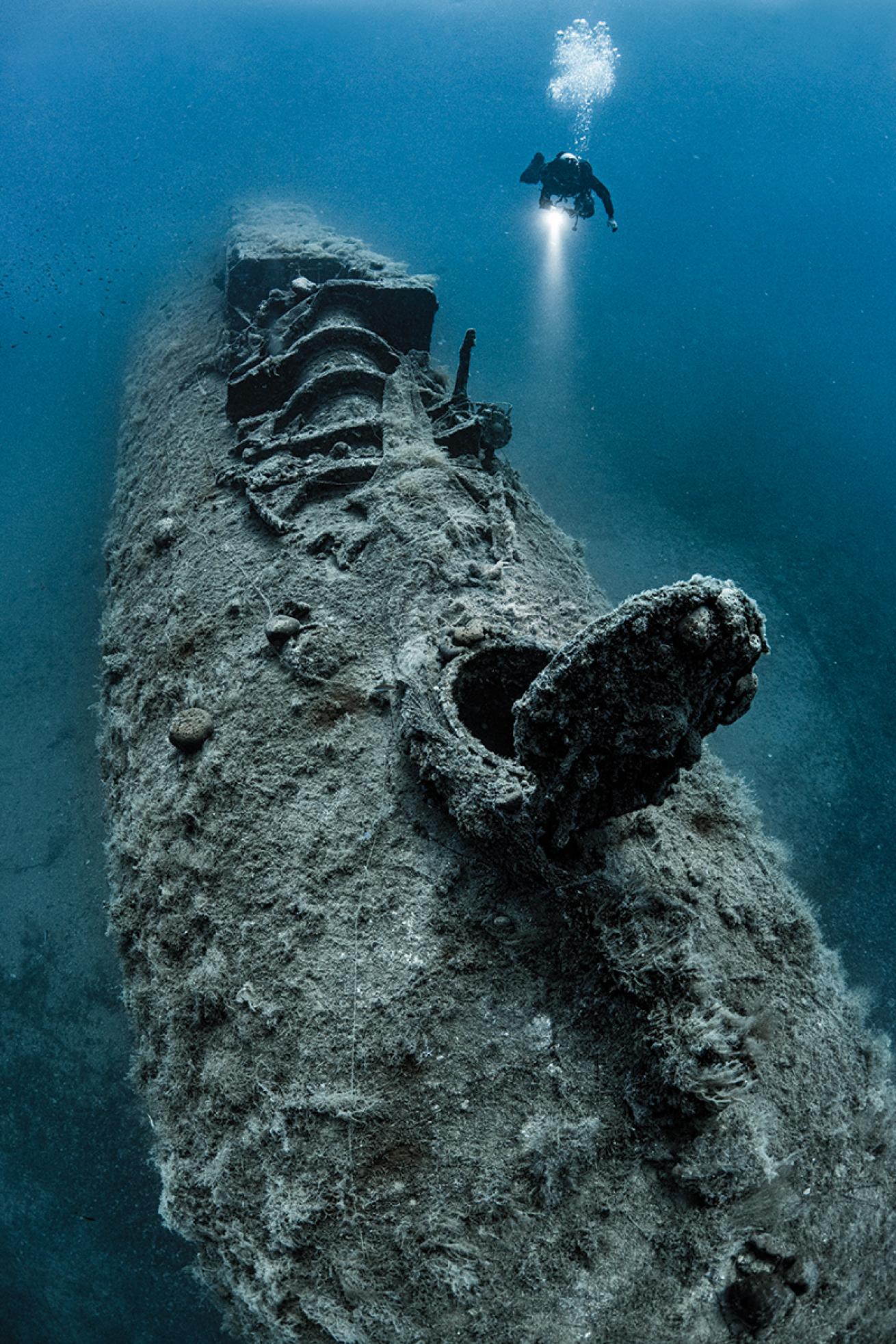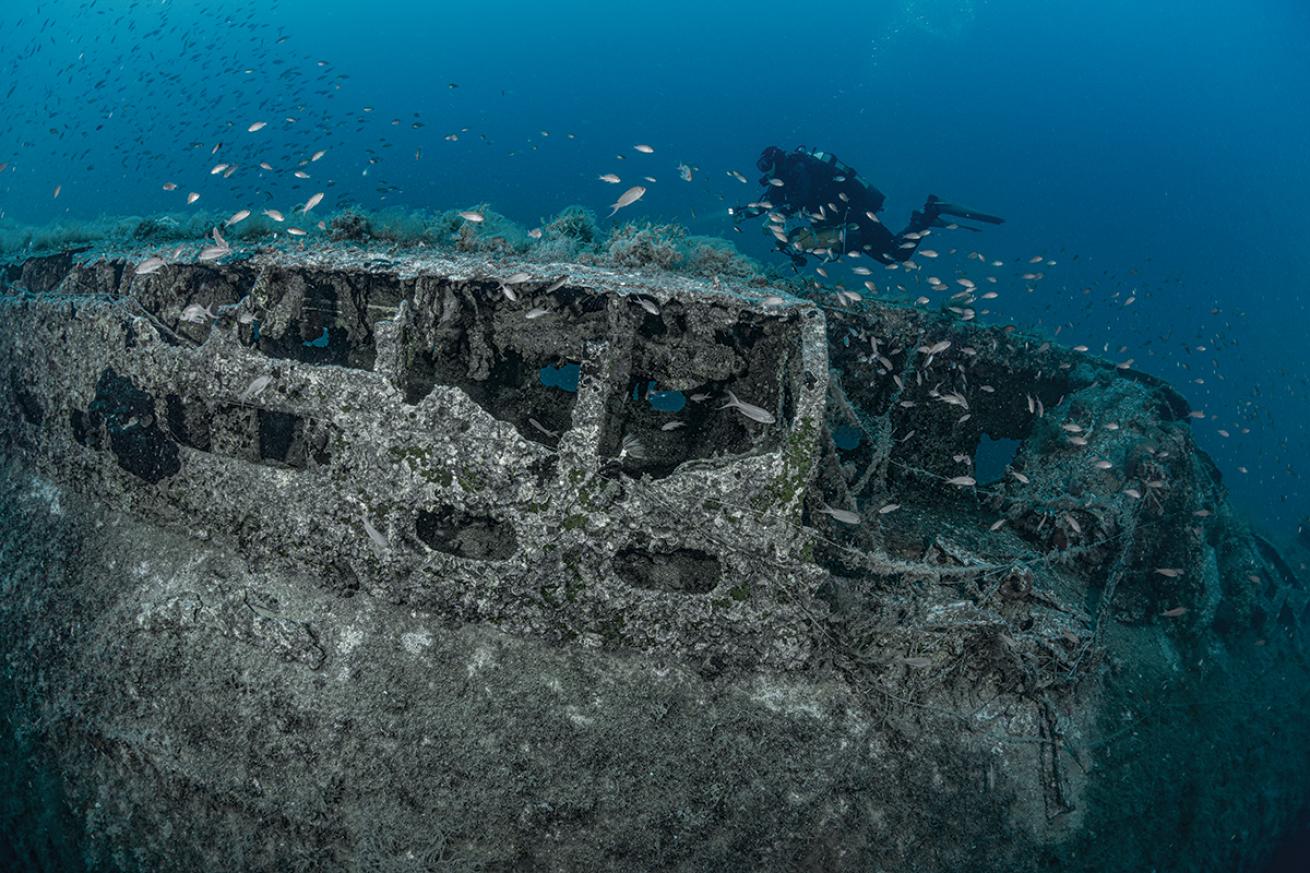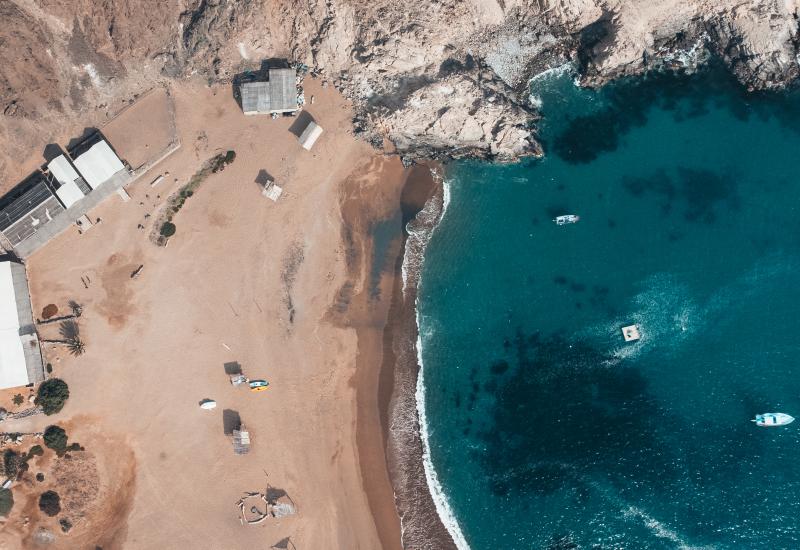Only One Man Survived This WWII Wreck — And You Can Dive It.

Martin StrmiskaThe conning tower is a distinctive feature on any submarine, and the one on Perseus was equipped with a massive 120 mm anti-aircraft gun. Its large size gives divers a bit of shelter from current at the shallowest part of the wreck, which cannot be penetrated.
The sailor lies on a makeshift bed next to torpedo tubes, rereading old letters, often his only contact with the outside world. Above him is a round escape hatch.
The mood on board is high: Yesterday, torpedoes fired from these tubes hit their target. The sailor eyes a bottle of rum lying beside him, but takes only a sip—the rest he saves for the happy moment when they enter the port of Alexandria, Egypt.
Suddenly, he hears a ghastly rumble. The hull shakes, and the sailor is thrown against the aft compartment. The scene is like something from an action movie: Shouts and cries come from all directions, electrical circuits catch fire, the lights go out, and panic takes over.
It all happens in an instant, but the sailor immediately knows what has transpired: The sub has hit a mine.
His senses tell him the boat is listing. The bulkheads tremble, and there is a rumble in his ears as water rushes in. At the time of the explosion, the vessel had been monitoring action at the surface, so the conning-tower hatch was open. When the desperate cries of sailors quiet, only the grim rumble remains. In seconds, heavily flooded Perseus plunges bow-first into the deep, a sinking coffin carrying 61 men to the bottom.
Perseus
Perseus was one of the largest submarines of World War II. Measuring 290 feet, the British warship was launched in May 1929. Compared to previous submarine classes, it was larger and had several improvements, the first class to be fitted with Mark VIII torpedoes. It also had new external-welded fuel tanks and gun shields.
Along with sister submarines of the same class—Proteus, Poseidon and Pandora—Perseus was deployed to the northeastern coast of China. After Italy declared war in June 1940, Perseus and its sisters headed to the Ionian Sea; in August 1940, under the command of Edward Christian Frederick Nicolay, Perseus joined the 1st Submarine Flotilla. On September 5, two torpedoes from Perseus hit the Italian tanker Maya 5; on October 2, in Libya’s Benghazi Canal, it sank the 2,086-ton merchant ship Castellon.
December 6, 1941, at 10 p.m., south of Kefalonia, Greece, Perseus watches and waits for an Italian convoy. Clouds obscure the stars, and a freezing wind blows.
John Capes is one of two passengers taking a lift to Alexandria. In fact, he’s also a mariner, the main stoker on the submarine HMS Thrasher. After a trip to Malta to resolve charges involving a rented car and a demolished horse-drawn carriage, he was ordered to board Perseus en route to Alexandria, where he would rejoin Thrasher.
Disaster
The darkness is complete. For a few seconds, Capes ceases to perceive the deafening cascade of water as he feels Perseus fall. A devastating bump throws him back to reality: They have hit bottom. Perseus lies on the bed of the Ionian Sea—by a miracle, its rear part is not yet flooded. Capes feels a sharp pain in his right thigh, but knows he must act quickly. In the dark, he reaches for the flashlight normally placed next to an emergency hatch. Another miracle: It is there, and it works! Looking for fellow survivors, he heads for the engine room.
As the flashlight pierces the foul-smelling gloom, he finds a ghastly sight. Dead men are everywhere. In the tangle of burned and bloodied bodies, he finds three living but badly injured sailors. The door to the engine room is closed, but not by human hands—water sprays through its rubber seal, meaning it is under severe pressure.
“That door saved us,” Capes would recall later. Helping the injured men get to the emergency escape hatch takes him half an hour, as the water level rises significantly. Bodies float all around.
Escape
Cold penetrates his bones. The water rises, and time is up. Everyone is already in the emergency room, but before the hatch opens, they must flood the chamber because the water is now pushing at the hatch with a weight of 10 tons. What if the explosion or impact deformed the ship’s body and the hatch won’t open?

Martin StrmiskaHaving a diver in the background of the shot emphasizes the size of Perseus.
The survivors kit up in a simple oxygen rebreather called the Davis Submerged Escape Apparatus, consisting of a hose, an oxygen bottle and a breathing bag. Capes checks the depth gauge—269 feet! If correct, their chances for survival are zero. An oxygen-supplying device is not designed to be used at such great depth. But there is no other way out.
The men put on goggles and a nose clip to prevent the leakage of gas from the loop. Capes finds a valve to equalize the pressure in the chamber. As dirty, oily water swirls around them, they breathe oxygen. Pressure equalizes, leaving a small pack of compressed air under the ceiling. Through pain and cramps, Capes opens the hatch and pushes the sailors out one by one, pulling himself through last.
He is out, suspended in cold darkness as the Davis apparatus carries him to the surface. He breathes, feeling a burning pain in his whole body. On his way up, he finds himself next to another floating mine. Scared, he holds his breath as long as he can. Finally, he reaches the surface and smells fresh air. With hope he waits for the three other seamen to break the surface. Foul air from the submarine bubbles in the rough seas. Nobody shows up.
He is the only survivor.
Below
Today there is no fixed line anchored to the shipwreck. Descending along a makeshift reference line, divers eagerly watch for Perseus to appear. Although its first outlines are visible at a depth of 100 feet, the “wow” moment comes with a view of the tower at 130 feet. The doomed submarine looks like a sleeping princess—untouched, quiet, yet as if she still has something to say, waiting for the kiss that will awaken her.
At the same time, the sub makes a mighty impression. The tower, seated on its huge hydrodynamic trunk, lends a commanding feeling of authority. Mild nitrogen narcosis roils a wave of thoughts and associations: Here is where the water flowed into the submarine...
The view of the bow reflects the destructive power of the vessel—torpedoes meant for the Italian convoy are still in their chambers. From here, missiles that sank the Maya 5 and the Castellon were launched. Viewing its perfect hydrodynamic shape, we can almost hear the damped noise of its engines and sonar.
The struggle for the lives of 61 men imprisoned by water plays out at the stern—an open emergency hatch and a hole nearly 2 feet in diameter tell the story in a split second. Although the sub’s sheathing is slowly breaking down, the body of the submarine is still in perfect condition; the escape hatch is the only way in and out. From that dark hole, the specter of death still looms.
Survivor

Martin StrmiskaWhile most of Perseus’ steel cladding is still in place, the thinner parts in the front of the vessel have succumbed to corrosion, revealing parts of its inner structure—the closest thing to an interior view divers can get.
Bobbing alone at the surface that night, Capes believed he was somewhere around Kefalonia. The last news heard from the tower said they were targeting an Italian convoy expected to pass south of the Ionian island. In the distance, he spotted lights. After a grueling eight-hour swim, he conquered the 5-mile distance and, exhausted, collapsed on a beach.
Good-hearted Greeks helped the castaway to safety, but since the island was under Italian occupation, all was kept secret; even the Greek intelligence service got involved. Eighteen months of disguises and ever-changing hideouts ended on May 31, when Capes left Kefalonia on a ship named Evangelistria.
Later investigation showed Perseus was not in fact as deep as Capes’ damaged gauge had indicated. But even its actual resting place—150 feet—is much too deep to breathe pure oxygen; how Capes survived is still a mystery. One theory says that the air in the flooded chamber was already so lean on oxygen that it took a few minutes for Capes to saturate himself. Another theory says that because Capes was a smoker, and had smoked in the engine room during the collision, his hemoglobin was partially saturated with carbon dioxide, which gave him more time. Or was it his will and the desire to live that saved him?
Whatever the answer, by his heroic act John Capes earned his life as well as the British Empire Medal, awarded to him in 1943.
About Perseus
Submarine Class: Parthian
Displacement: Surface, 1475 tons; submerged 2,040
Length: 290 feet
Width: 30 feet
Draft: 16 feet
Range: 8,400 nautical miles at 10 knots
Speed: 17.5 knots, 8.5 knots submerged
Diving Depth: 500 feet
Torpedoes: 14 (21-inch tubes)
Need to Know
When to Go September and October are the best months to dive Perseus. The water is usually still warm, visibility can reach 80 to 100 feet and tourist facilities are not as busy as in July and August.
Dive Conditions Conditions on Perseus vary from one day to the next. Seas can be rough, and currents can have varying strengths at different depths.
Operators PADI dive centers Blue Manta and Pirate Divers Club offer trips to HMS Perseus for experienced divers with a Deep Diver Specialty certification. Technical diving trips also are possible on request for qualified divers.










